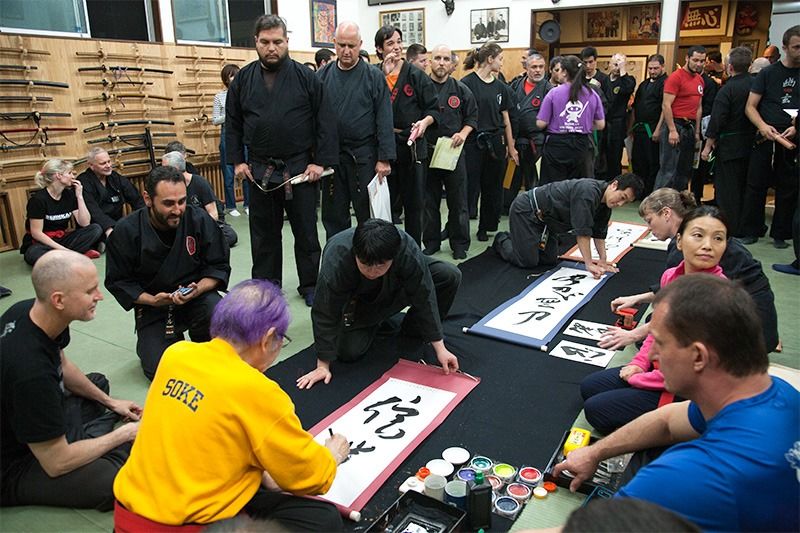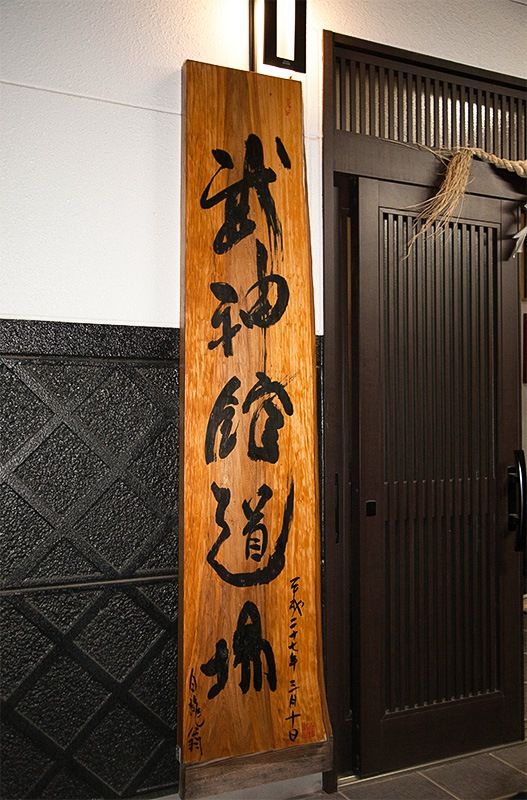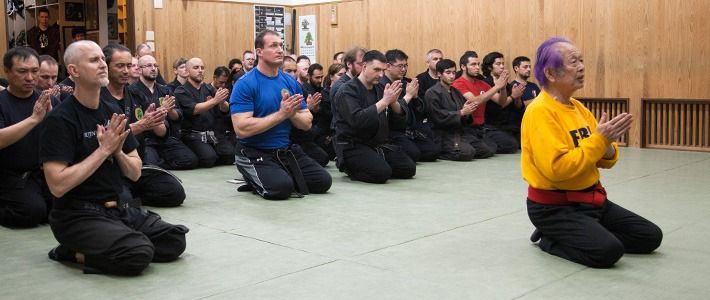
“Cool Traditions” Stay in Tune with Modern Life
Hatsumi Masaaki, the World’s Most Famous Ninja, and His Essence of Martial Arts
Culture- English
- 日本語
- 简体字
- 繁體字
- Français
- Español
- العربية
- Русский
Where the World’s Warriors Gather
An hour’s train ride from central Tokyo, muscular martial artists from around the world appear in the streets near Noda’s Atago Station on the Tōbu Urban Park Line. This is the home of the Bujinkan martial arts dōjō. When the sun starts going down, a stream of foreign visitors begin getting off the train in this drowsy commuter town. When we ask a station attendant for directions to our destination, he describes the route with practiced ease. Then he adds, with a nod toward the foreign visitors, “Just follow them.”
Bujinkan is the dōjō of Hatsumi Masaaki, the thirty-fourth sōke head of the 900-year-old Togakure school of ninpō, the fighting arts of the ninja. Building on the foundations of Togakure ninpō, Hatsumi instructs his students in his own Hatsumi school of ninjutsu fighting, incorporating techniques drawn from both ninjutsu and many other ancient martial arts tracing their origins hundreds of years back in Japan’s past. On the day we visit Bujinkan to speak with its famed master, the 50-tatami-mat practice hall is packed to overflowing with nearly 100 of his deshi, or students.
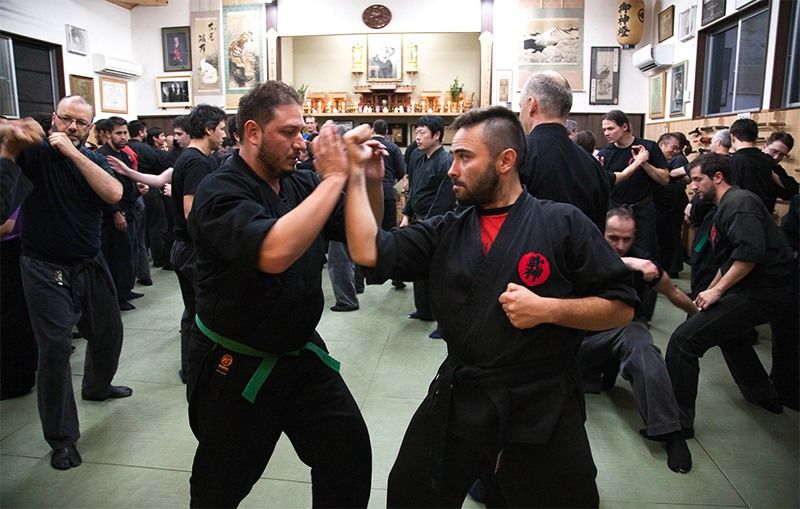 Deshi from around the world practice techniques at Bujinkan.
Deshi from around the world practice techniques at Bujinkan.
One of these disciples is 47-year-old Christian Petroccella, who spent nearly 30 hours on a series of airplanes and trains to reach the dōjō from his native Argentina. Since receiving deep lessons in ninjutsu from Hatsumi, Petroccella has organized more than 500 seminars on Japanese martial arts all around the world.
“I’ve been a deshi at Bujinkan for thirty-two years,” Petrocella tells us, “and this is my fiftieth visit to Japan. To me, Hatsumi-sensei is both a brilliant instructor and my master in the art of living. The sensei is always able to bring out the best in me. It doesn’t matter how far I have to travel to get here. Why wouldn’t I keep coming back year after year?”
The Soul of Ninjutsu
“Hai! OK!”
Hatsumi’s powerful voice seems to reverberate from the pit of his stomach. Instantly the talking, laughing deshi fall silent and follow their teacher’s every movement with hungry eyes. Hatsumi speaks almost like a lecturer presenting a theory as he explains, “You do not try block your opponent’s attack. You feel his attack. It is not a question of strength or speed. It is all about control.”
At a signal, a deshi nearly twice Hatsumi’s size charges the sensei. No sooner has the 86-year old seized his attackers arm than in an almost instantaneous, flowing movement, he has laid him flat out on the dōjō floor. The flattened deshi lets out a low groan. His face says it all: “I’m whipped.”
Perhaps because Hatsumi’s performance was so brilliantly smooth, both the flattened deshi and all his watching colleagues for a moment seem completely baffled as to what has happened. Then they burst into admiring laughter.
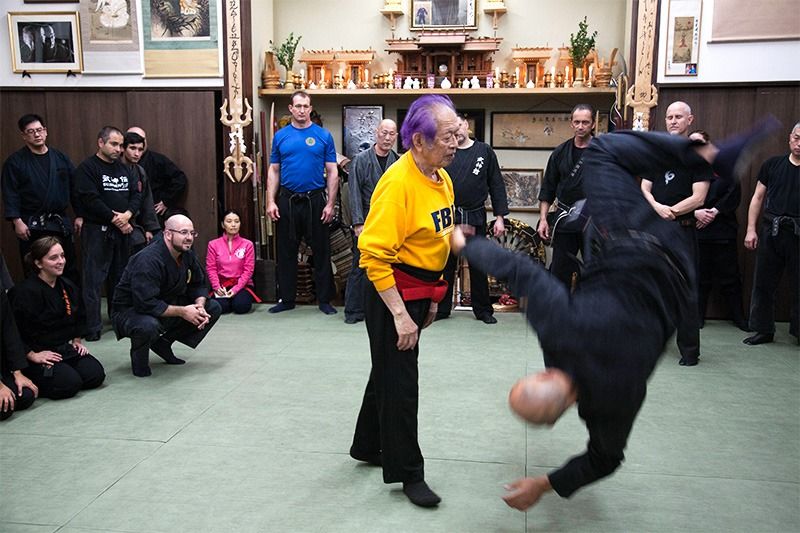 Hatsumi easily throws a towering student.
Hatsumi easily throws a towering student.
 Baffled at how easily he has been defeated, the student can only join in the laughter.
Baffled at how easily he has been defeated, the student can only join in the laughter.
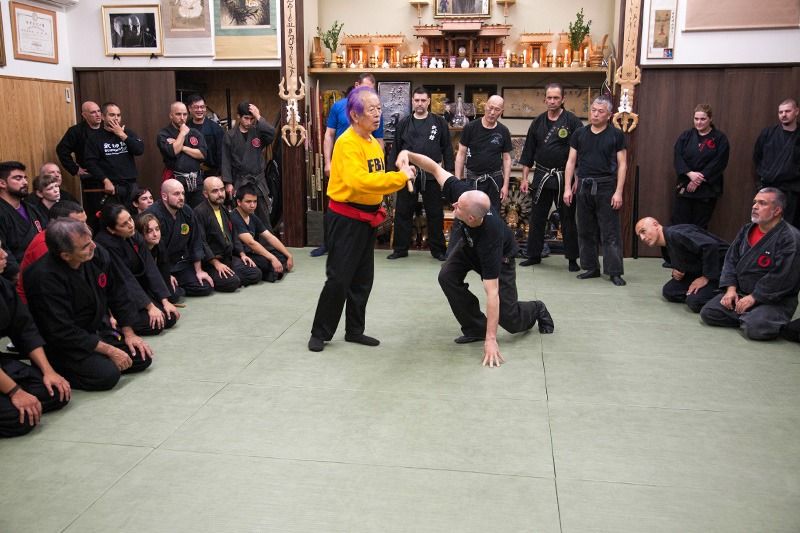 Hatsumi’s deshi concentrate on his demonstration of the technique.
Hatsumi’s deshi concentrate on his demonstration of the technique.
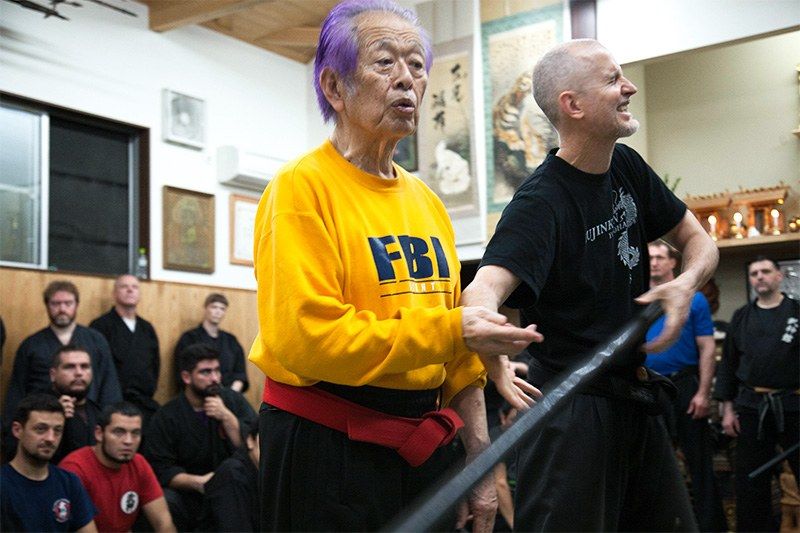 Hatsumi applies what seems the lightest of touches, but it leaves his opponent grimacing in pain.
Hatsumi applies what seems the lightest of touches, but it leaves his opponent grimacing in pain.
“Hai! Play!”
At Hatsumi’s snapped command, his deshi now all break out into pairs and try to replicate the sensei’s demonstration themselves. “Here I do not teach,” Hatsumi explains to us afterward. “That is because I believe that instead of simply educating, it is far more effective to demonstrate how I myself move, and have the students incorporate that into their own movement themselves. Of course, the kata [the formalized set of stances and movements associated with a martial art] are the foundation of all we do here. Yet no matter how skillful you may become at kata, by themselves they are not enough.”
Hatsumi pauses, then declares about the skills of the ninja: “Ninjutsu is not a sport. Ninjutsu is a skillset for staying alive. There is no rule to ninjutsu. Not a single one.”
Yet Hatsumi’s movements are in fact almost unbelievably complex. He seems able to block an opponent’s movements with a single finger, and then with consummate ease bring him to the floor with just two or three deft hand movements. Or perhaps it would be more appropriate to say that, rather than defeating his opponents, he leads them into defeating themselves. One of his deshi explains it this way after he has faced the treatment himself: “I was frozen. I couldn’t lift a finger.” And indeed, an inexperienced watcher can watch Hatsumi’s demonstrations time and again and still barely begin to comprehend what has happened. When you recall that this martial arts master is already in his mid-eighties, you can only be amazed by the nimble way he carries himself.
Even more baffling is that at no time does Hatsumi seem to be using much physical strength. The flow of his body is smooth and precise. How did the sensei acquire such technique?
His explanation is philosophical and profound. “In the same way that we human beings naturally keep our balance as we go about our daily lives, we need to be able to quickly re-find that balance under every circumstance. My movements are the result of long training to achieve that skill. This level of control is something that cannot be completely explained by logic alone, nor is it something you can comprehend just by watching it once. My deshi are all accomplished martial artists who have been training for decades. The reason they continue to practice here is because they know that perfection is not so easily achieved.”
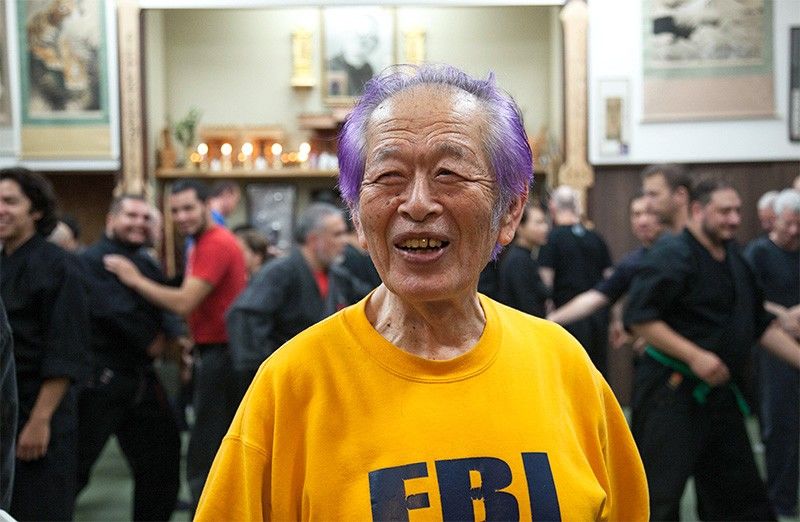 Hatsumi wears a sweatshirt he says was a gift from the US Federal Bureau of Investigation. On the back, matching letters spell out “SOKE,” transliterated from the Japanese term sōke, the head of a school. When asked why he dyes his hair an electric purple, he beams: “Because my wife thought I should give it a try!”
Hatsumi wears a sweatshirt he says was a gift from the US Federal Bureau of Investigation. On the back, matching letters spell out “SOKE,” transliterated from the Japanese term sōke, the head of a school. When asked why he dyes his hair an electric purple, he beams: “Because my wife thought I should give it a try!”
Studying Under the “Mongolian Tiger”
Hatsumi’s mastery of his art is clear. What first led him to walk the path of the martial artist and to pursue it to this level of achievement?
“When I was a child Japan was at war,” he tells us. “We were urged to learn martial arts, and I practiced karate, boxing, and jūkendō [a martial art form that evolved from fighting with rifle bayonets, or jūken, in combat]. In jūdō I earned the fifth dan rank. After the war, when I was in my twenties, I taught jūdō at the US base established by the US Occupation forces on the site of the former Imperial Japanese Army Airforce base in Tachikawa, western Tokyo. That was where I saw with my own eyes Japanese black belt holders being taken out time after time by completely novice foreign fighters. I realized then that all the martial arts I had studied so far were useless in the face of such physically powerful opponents.”
It was at this moment in his life that Hatsumi met a legendary figure in the history of contemporary Japanese martial arts, Takamatsu Toshitsugu (1889–1972), better known in Japan by the striking moniker, Mōko no tora—the Tiger of Mongolia.
“Takamatsu-sensei had not only received the secrets of ninjutsu but had ten years’ experience actually using them in battle in China,” Hatsumi remembers today. “The first time I met the sensei my very body froze in his overwhelming presence. I thought to myself that here, at last, was the real thing. I became his deshi, and over the course of long years of training and discipline, my own martial arts slowly transformed into something real. I am only here today because of my sensei.”
Hatsumi became Takamatsu’s student when he was still 27 and studied under him until his sensei passed away 15 years later. Almost every week Hatsumi would take the overnight train from Noda to Kashihara, Nara Prefecture, to practice. On the kamidana Shintō altar in Bujinkan’s practice hall stands a large photograph of Takamatsu. “He is always looking out for me,” says Hatsumi with a serene expression on his face.
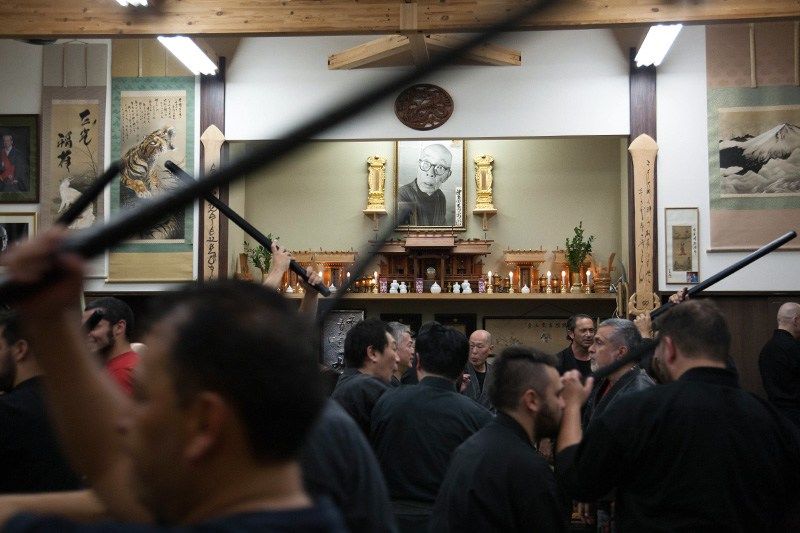 The dōjō’s kamidana altar with a photograph of Hatsumi’s late teacher, Takamatsu Toshitsugu.
The dōjō’s kamidana altar with a photograph of Hatsumi’s late teacher, Takamatsu Toshitsugu.
Instructed in the inner arts of nine schools of ninjutsu, including the Togakure school, by his master, Hatsumi resolved in his late thirties to establish the Bujinkan and begin training the next generation. In his fifties, he started taking his training abroad. Over the next 25 years he travelled to more than 50 countries around the world, from the United States and Europe to the Middle East, Africa, and South America.
Hatsumi’s instruction, grounded in actual real-world applications, has been praised wherever he goes. He has been named an honorary citizen of Los Angeles, Atlanta, and other world cities, and has received testimonials and letters of appreciation from the FBI and the United Kingdom’s Special Air Service forces.
A World-Spanning Network of Deshi
“Japan is known as the home of ninjutsu,” says Hatsumi. “Yet the tradition itself is very deep, and if you go back far enough in time, it’s thought that martial arts similar to ninjutsu once existed in every corner of the world. In fact, you could say that ninjutsu is a forte of the human race as a whole. When I first began providing instruction in the United States, I used to joke to the students: ‘I’m not from Japan. I’m from no country. I’m a UFO!’ And then, when I instructed them in ninjutsu without creating any of those kinds of divisions, I soon became friends with people all over the world.”
Today Hatsumi is said to have as many as 300,000—some even say 500,000—former and current students scattered around the planet. “I myself don’t know how many deshi I have,” he admits. “I have master students who have practiced under me for many long years—my daishihan—who now provide instruction themselves all over the world. Nowadays many of the students who come to Bujinkan are second-generation pupils of masters who first studied under me. My daishihan train deshi of their own, and then their students go on to train their own deshi in turn. The circle of Bujinkan followers just keeps on growing.”
On the day we visited, nearly 90% of Hatsumi’s students were from other countries. Many were muscle-bound men, but there were also ordinary-sized male participants, as well as many women students. Explains Hatsumi, “My students range from people who put themselves in the line of fire every day—like policemen and soldiers—to individuals on elite tracks like medicine and the law. One of my women deshi is a doctor. She tells me that she wants to learn the skills to manage and subdue out-of-control patients.”
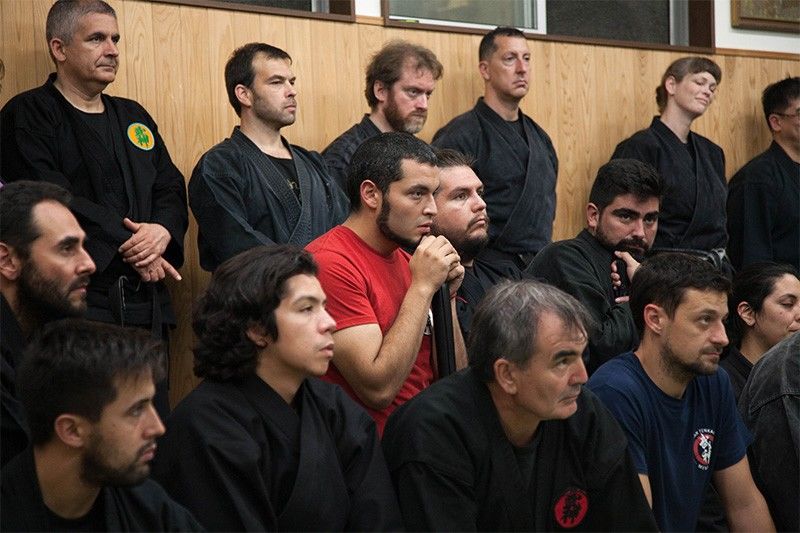 Hatsumi’s deshi follow his every move with hawk-like attention.
Hatsumi’s deshi follow his every move with hawk-like attention.
What do the deshi themselves say about their Bujinkan experience? One 43-year-old Vietnamese man, who works in his own country as a lawyer and has opened a dōjō of his own back home, says that he still comes to practice at Bujinkan whenever business brings him to Japan.
“It’s been seventeen years since I started coming to Bujinkan,” he recalls. “I was always fond of martial arts and I tried my hand at many of them myself, but what truly sets the skills taught here apart is that they extremely practical. Other martial arts traditions hold lots of competitions, and the desire to win drives you to rely on your physical strength. That means lots of injuries. Bujinkan’s martial arts are practical. There are no artificial rules or competitions, and whether you are physically strong or weak doesn’t work to your advantage or disadvantage. I feel like my life has been heading in a better direction ever since I started coming here to practice.”
Passing on the Heart of Ninjutsu
During a break in the training, the deshi begin to form a line in front of Hatsumi. Everyone seems in great humor. Once all are ready, Hatsumi speaks to each of them in turn as he writes calligraphy on their proffered scrolls and shikishi autograph boards in a smooth, practiced hand. Each student holds the calligraphy like a precious gift as they leave the dōjō for the day.
The fifteenth dan is the highest rank one can attain at Bujinkan. On the day that we visit, Hatsumi is conducting proficiency tests for promotion to fifth dan. The deshi kneel in formal seiza position with their backs turned to the examiner as he passes behind them with a training weapon called a bōken, a cushioned bamboo staff covered in leather. No one knows when or on whom the bōken will fall, and the test is to see if the deshi can avoid the blow relying on their senses alone. If they can, they pass.
Upon promotion to fifth dan, the deshi receive certificates that permit them to open their own dōjō. The faces of the qualifying students beam with delight and satisfaction.
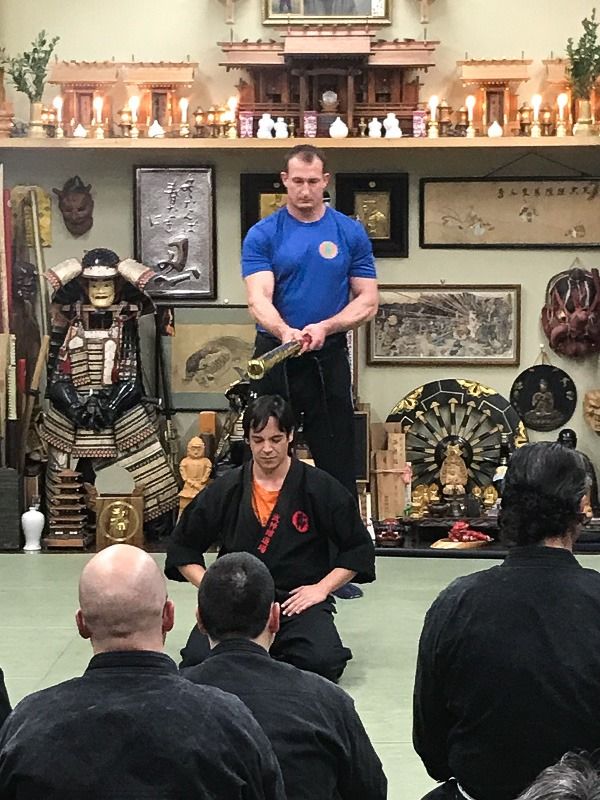 The test for promotion to fifth dan. You pass if you can avoid the descending bōken using your senses alone
The test for promotion to fifth dan. You pass if you can avoid the descending bōken using your senses alone
“Perfecting a martial art is not an easy path,” says Hatsumi, casting his mind back over his own long journey. “I have come as far as I have in this life out of my one great desire, to help lead other people to know the true ninjutsu, to know the true martial arts. It’s been fifty years since I first opened this dōjō, and at last I’ve been able to train and raise successors from all over the world. I’m just content that I have been able to pass on the true essence of martial arts. All I want now is for my deshi around the world to continue to learn and grow into outstanding people who can earn the respect of all.”
(Originally published in Japanese on May 18, 2018. Reporting and text by Ōnishi Yuka of Power News. Photos by Yokoyama Takeshi. Banner photo: Hatsumi Yoshiaki and his students pay their respects to the Bujinkan kamidana Shintō altar before beginning their practice.)